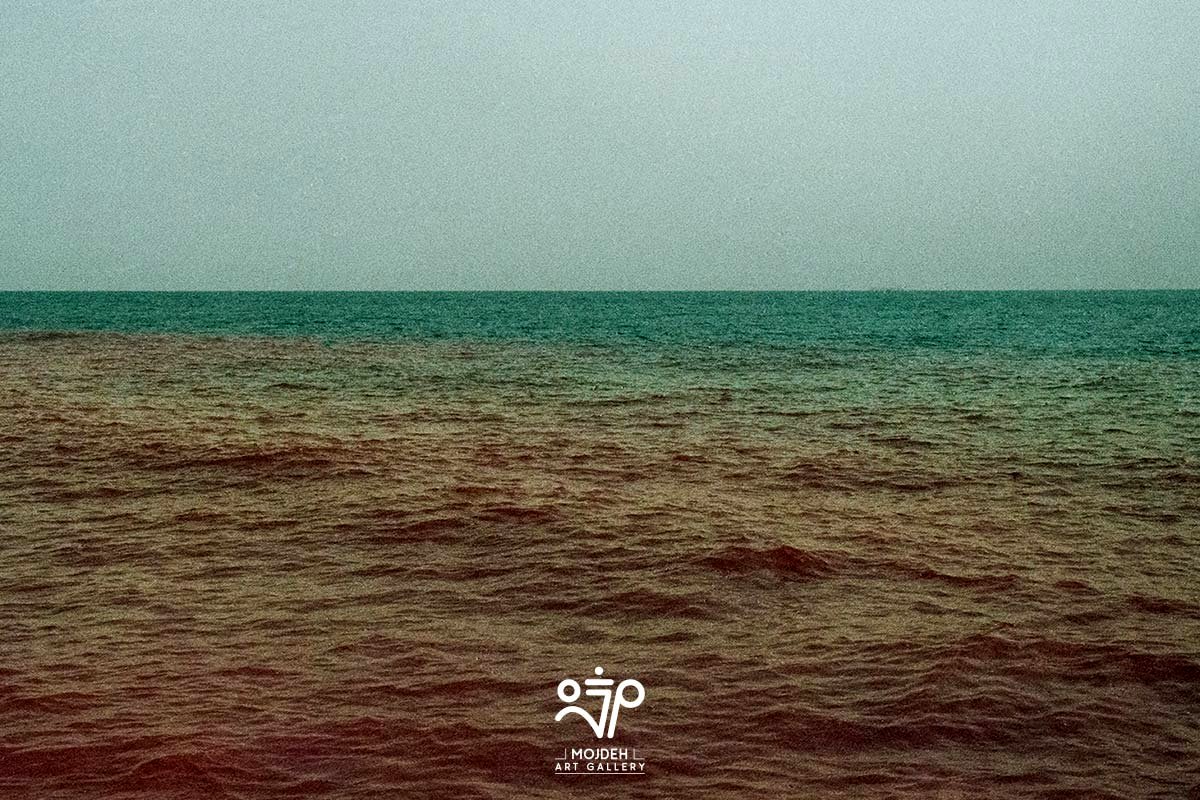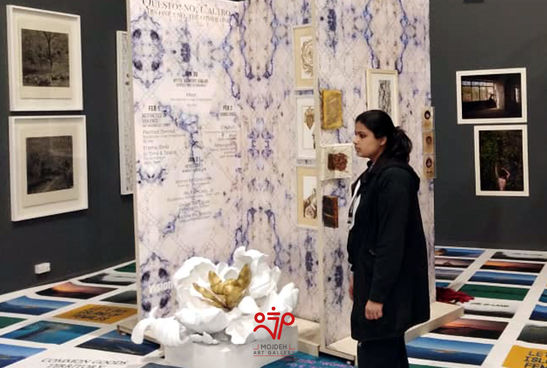Meaning in the Game of Color and Light

The collection of Babak Haghi photographies has created the visual space in a way that in which the four elements of nature have the role of signifying by playing with the color and light. If we want to analyze these photos by semiotic method, we can divide the photos into four categories: Three-element photographs with a combination of air, water and soil, an object left on the shore and placed in the line of demarcation between the two elements of soil and water. Two-element photographs of soil and water, two-element photographs of air and water with object or body, three-element photographs of water and soil and air with body. The common denominator of these photos is the element of light, which causes the colors to present themselves in different ways.
First of all, we must say that in semiotics, the main discussion is the production of meaning and the description of the reproductive process of meaning, and the image is considered as the text. In fact, photographic action is like enunciation, the result of which is expressed in words and text, and the analysis of the text is done through the expression plan and the content plan. Production in the manner of photography, that is, the production of an artwork as text. The text is important as a result of the narrative and has a dual agent: human agent and non-human agent which is the camera. As Jean-Marie Floch states: "If from a technical point of view the photographic image is a reflection of the artist, this is the forms of reflection that make the mechanism of the image a significative and meaningful subject."( Floch, 1995, p.170 ) It should also be noted that the semiotics of photography is not just about visual sign, but about the mechanisms of visual perception that are involved in the production of meaning. The photograph is first and foremost a system of communication and has a dynamic structure. In this collection, which shows Babak Haghi's interest in the four natural elements, beautiful combinations with the artist's color taste can be seen, which also shows his visual interest. The play of color and light and showing elements such as water, air, soil focuses especially on the plastic aspect rather than the visual aspect. This is the plastic aspect that is mostly producing meaning and one of its important elements is color. For further explanation, it is necessary to mention that we have two types of languages in an image: the image itself, which is the pictural language, and the language of the plastic (visual) (color, direction, and position of the image on the surface, lines, and shape). These two languages are compatible. Plastic or visual language is an expressive form for figurative or pictural language. What stands out most in Babak Haghi's photographs and attracts the viewer's attention are the colors created by the light on the surface of the water. Different blues such as sky blue, greenish, gray, reddish. Regarding the color element, it should be said that color is a subset of light that helps to see and targets the object. In fact, it is the color that localizes the material and shows the surface and depth, turning it into a beautiful symbol, full of feeling, energy and fluidity. We should add that the colors in the photo depend on the light source, which in some of the photos in this collection also shows the light element. As Fontanille puts it: "The intensity of light depends in some way on the object itself or on that place: warm or cold colors, saturated or unsaturated, can be interpreted as light sources, depending on the tonality of the color and its value in the image or painting."(Fontanille, 1995, p. 32). Color engages us in a narrative through which we seek meaning. This narrative manifests itself in various ways through a photo frame. This is the color that frames the space for us and keeps us on the surface or takes us deeper. The experience of feeling color is intertwined with the visual reception and perception of objects. In The Phenomenology of Emotion (1945), Merleau-Ponty describes this constant perception in detail, which becomes tangible and objective in the form of color matter in what we see. It is a visual experience that constantly displays a particular color that is related to different moments of capturing the moment, these moments of perception of light and color are recorded by the enunciator of the collection. The moment when the light shines is the moment when that range is illuminated and all the images are displayed. Each of the four elements is represented by the color that plays the main role, and the color stabilization appears as the moment of its capturing, such as the bluish gray, the red on the sea. Ultimately, it is the depth of the image that creates the color. Blue is the deepest of all colors, not only brightens the material but also makes it clear. In fact, is the thickness of a pure and clear material. The color blue itself comes from air, water, crystals, and diamonds. Light also gives meaning to the text. In other words, light as matter occupies a form of space. In fact, it is the light that informs us of the presence of place and volume. According to Jacques Fontanille, the state of light as matter "together with color creates a space, a visual space, which even shows the depth of the surface." (1995, p. 35). Light as matter in the visual world requires the presence of the five senses, especially the sense of touch. In this case, it is as if light gives the gaze hands to touch the surface of the sea. This combination of the sense of sight with the sense of touch, which Jill Deleuze calls "optics", is specific to the meeting or the world of light. It should be said that the viewer is able to recognize lines, surfaces, volume, etc. through light. The gaze passes through the thickness, follows the lines and recognizes the surfaces. In some photos, the light is placed on the water as if it could be touched.

After color and light, objects are in the realm of the four elements and subconsciously want to become one with nature. Objects left in place, a fisherman's bundle placed on the shore, sticks in the water, a tree on the shore, and so on. The perceptible presence of objects on the surface of the soil, which has low extensity and intensity compared to air and water, deepens and makes the viewer’s gaze purposeful, and the human body intends to unify itself with natural elements and consciously release itself in nature as an object. The kind of liberation that the enunciator has shown well with the play of color and light.
As a result, it should be said that the enunciator has created a language with color and light, which makes meaning in several ways and has its own syntax. Manifestation of four natural elements, tangible presence of object and body, relationship between dimensions through color and light. The perceptible presence of objects and body is related to the perceptual values of color and light and manifests itself in a space that is the extensity and intensity of the natural elements water, air, soil and fire (hidden in light) and the relationship between these factors ultimately shows the emotional and perceptual body, which symbolizes the tangible presence that touches objects on the shore (soil) or the sea (water) and eventually merges with them, and all together intend to reach unity.
Marzieh Athari Nik Azm


